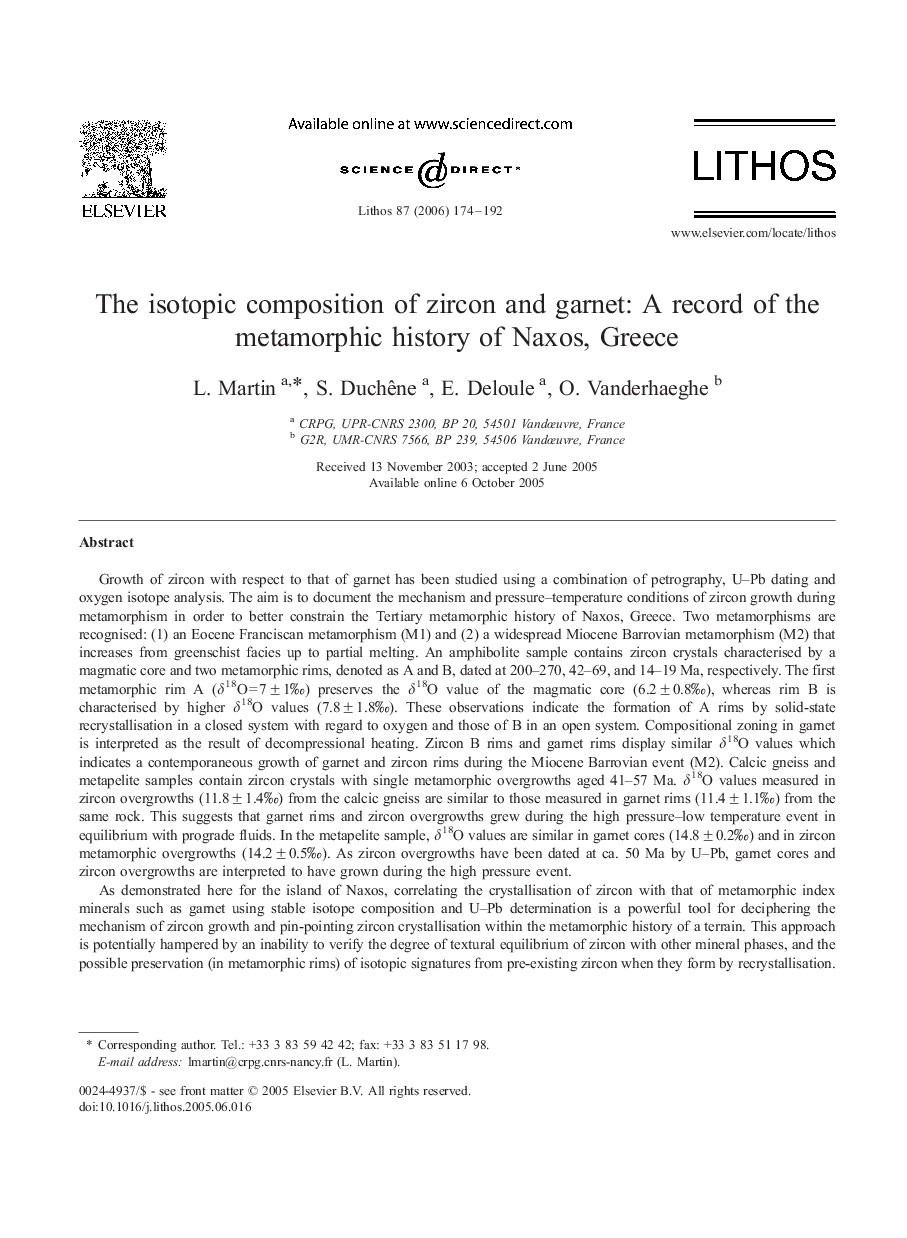| کد مقاله | کد نشریه | سال انتشار | مقاله انگلیسی | نسخه تمام متن |
|---|---|---|---|---|
| 4718046 | 1638782 | 2006 | 19 صفحه PDF | دانلود رایگان |

Growth of zircon with respect to that of garnet has been studied using a combination of petrography, U–Pb dating and oxygen isotope analysis. The aim is to document the mechanism and pressure–temperature conditions of zircon growth during metamorphism in order to better constrain the Tertiary metamorphic history of Naxos, Greece. Two metamorphisms are recognised: (1) an Eocene Franciscan metamorphism (M1) and (2) a widespread Miocene Barrovian metamorphism (M2) that increases from greenschist facies up to partial melting. An amphibolite sample contains zircon crystals characterised by a magmatic core and two metamorphic rims, denoted as A and B, dated at 200–270, 42–69, and 14–19 Ma, respectively. The first metamorphic rim A (δ18O = 7 ± 1‰) preserves the δ18O value of the magmatic core (6.2 ± 0.8‰), whereas rim B is characterised by higher δ18O values (7.8 ± 1.8‰). These observations indicate the formation of A rims by solid-state recrystallisation in a closed system with regard to oxygen and those of B in an open system. Compositional zoning in garnet is interpreted as the result of decompressional heating. Zircon B rims and garnet rims display similar δ18O values which indicates a contemporaneous growth of garnet and zircon rims during the Miocene Barrovian event (M2). Calcic gneiss and metapelite samples contain zircon crystals with single metamorphic overgrowths aged 41–57 Ma. δ18O values measured in zircon overgrowths (11.8 ± 1.4‰) from the calcic gneiss are similar to those measured in garnet rims (11.4 ± 1.1‰) from the same rock. This suggests that garnet rims and zircon overgrowths grew during the high pressure–low temperature event in equilibrium with prograde fluids. In the metapelite sample, δ18O values are similar in garnet cores (14.8 ± 0.2‰) and in zircon metamorphic overgrowths (14.2 ± 0.5‰). As zircon overgrowths have been dated at ca. 50 Ma by U–Pb, garnet cores and zircon overgrowths are interpreted to have grown during the high pressure event.As demonstrated here for the island of Naxos, correlating the crystallisation of zircon with that of metamorphic index minerals such as garnet using stable isotope composition and U–Pb determination is a powerful tool for deciphering the mechanism of zircon growth and pin-pointing zircon crystallisation within the metamorphic history of a terrain. This approach is potentially hampered by an inability to verify the degree of textural equilibrium of zircon with other mineral phases, and the possible preservation (in metamorphic rims) of isotopic signatures from pre-existing zircon when they form by recrystallisation. Nevertheless, this study illustrates the application of this approach in providing key constraints on the timing and mechanism of growth of minerals important to understanding metamorphic petrogenesis.
Journal: Lithos - Volume 87, Issues 3–4, April 2006, Pages 174–192